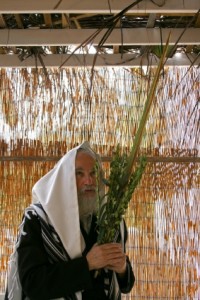Sukkot and the Sukkah
Written by Zev on October 13, 2008 – 11:00 pm -The festival of Sukkot begins on the 15th day of the Hebrew month of Tishrei, which is 5 days after Yom Kippur and lasts for 7 days. It is immediately followed by the holidays Shemini Atzeret and Simchat Torah.
Sukkot is named after the plural form of Sukkah – the type of hut that Moses and the Israelites lived in as they wandered the desert for 40 years before they reached the Promised Land. These huts were made of branches and designed to be portable.
In English, Sukkah is sometimes translated as ‘booth’ or ‘tabernacle’, hence Sukkot is also known in English as the ‘Festival of Tabernacles’ or ‘Festival of Booths’.
During this holiday, Jews construct and reside in Sukkahs. Here families eat their meals, entertain guests, relax, and even sleep if weather and space permit it. It is important for to share meals with others. In fact this sharing is so important that the holiday is also know as Chag Ha’asif, Festival of the Ingathering.
The walls of the sukkah can be made from any material, including wood, canvas, plaster, or regular walls of glass or aluminium. A sukkah may be free-standing, or include one or two sides of a building or porch in its structure. The roof of a sukkah, however, must be of organic material that is detached from the ground. Palm fronds, branches, bamboo and wood are the most common roofing materials. The amount of shade inside the sukkah must exceed the amount of sunlight that can enter through the roof.
One of the best known Sukkot ceremonies is the waving of the ‘four species’ – three branches and one fruit, depicted in the above photo. These consist of the following:
Lulav – a ripe, green, closed frond from a date palm tree
Hadass – boughs with leaves from the myrtle tree
Aravah – branches with leaves from the willow tree
Etrog – the fruit of a citron tree
The ceremony is prescribed by the Torah, and contains symbolic allusions to a Jew’s service of God.
For more information including a video on how to build a Sukkah, click on more.
How to build a Sukkah
EXternal Links:
http://www.holidays.net/sukkot/story.htm
http://en.wikipedia.org/wiki/Sukkot
Tags: sukkah, sukkot
Posted in Festivals, Judaica | No Comments »





You must be logged in to post a comment.